Trick r Treat, bless its spooky soul, helped make anthologies cool again. Since that wonderful release, we’ve seen a rise in movies that are essentially short story collections. Some of them are really good (Tales of Halloween, V/H/S 1 and 2, Southbound, and the absolutely phenomenal TV shows Channel Zero) and some haven’t been so good (Ghost Stories, Holidays, XX, Mexico Barbaro). Point being, you never really know what to expect from anthology films. After all, the whole point is that the short films are all made by different directors, so you have different voices adding to the mix (except in the case of Trick r Treat, of course). I went into Nightmare Cinema with high hopes that it would be worthwhile and the results were… well, let’s go through the short films one at a time, shall we?
The Wraparound Story: “The Projectionist” dir. Mick Garris
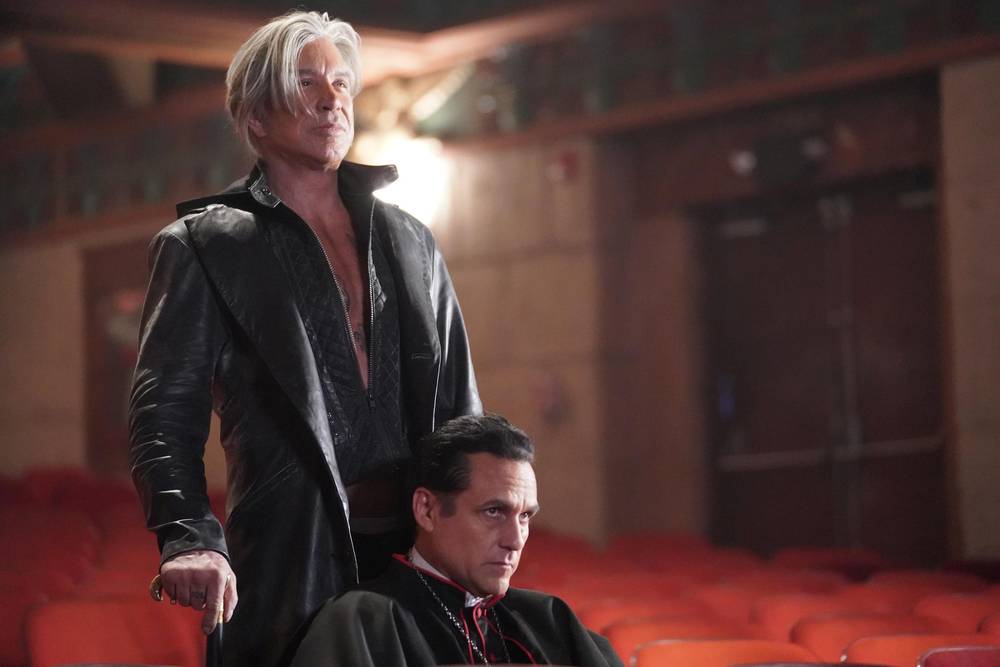
Serving as the movie’s framing device, “The Projectionist” is about a haunted movie theater that… I think shows people visions of the future? Five different people show up at the theater and see short films starring themselves. I like this concept as an excuse to have all these stories together, and there’s something enticingly creepy about a theater that appears out of nowhere to show you bad things.
The problem is its execution. In the very beginning, we see Samantha Smith just walk down the sidewalk and into the theater. She sits down and immediately, the first movie starts playing. This happens over the course of about a minute, and it leads to severe whiplash to set the tone. It’s very confusing at first, and later appearances by characters don’t do much to develop the story.
Mickey Rourke plays the eponymous Projectionist, but he honestly phones it in. Each section he’s in mostly consists of a character who he is and him grumbling “I’m the Projectionist. Welcome to my nightmare.” Then he kind of limps away and another movie plays.
It’s clear the filmmakers were trying to make him into some sort of new horror icon, but nothing about him is iconic. Rourke is good when used in a particular way, but he sleepwalks through his few lines of dialogue. His visual design is just Mickey Rourke wearing jeans and a tight-fitting vest and nothing else on his torso. He’s not menacing or charming enough to join the likes of the Crypt Keeper or Sam in the halls of famous anthology icons. And the pacing is so perfunctory that we don’t even get a good sense of what this place is, what the Projectionist wants, or why he does what he does.
I don’t mind ambiguous wraparound stories. The V/H/S movies don’t shed any light on why their tapes exist or where they come from, but in that case, it just makes everything creepier. Here, it feels like Garris was trying to convey some kind of lore. Alas, “The Projectionist” falls flat as both a wraparound story and as its own tale.
“The Thing in the Woods” dir. Alejandro Brugues
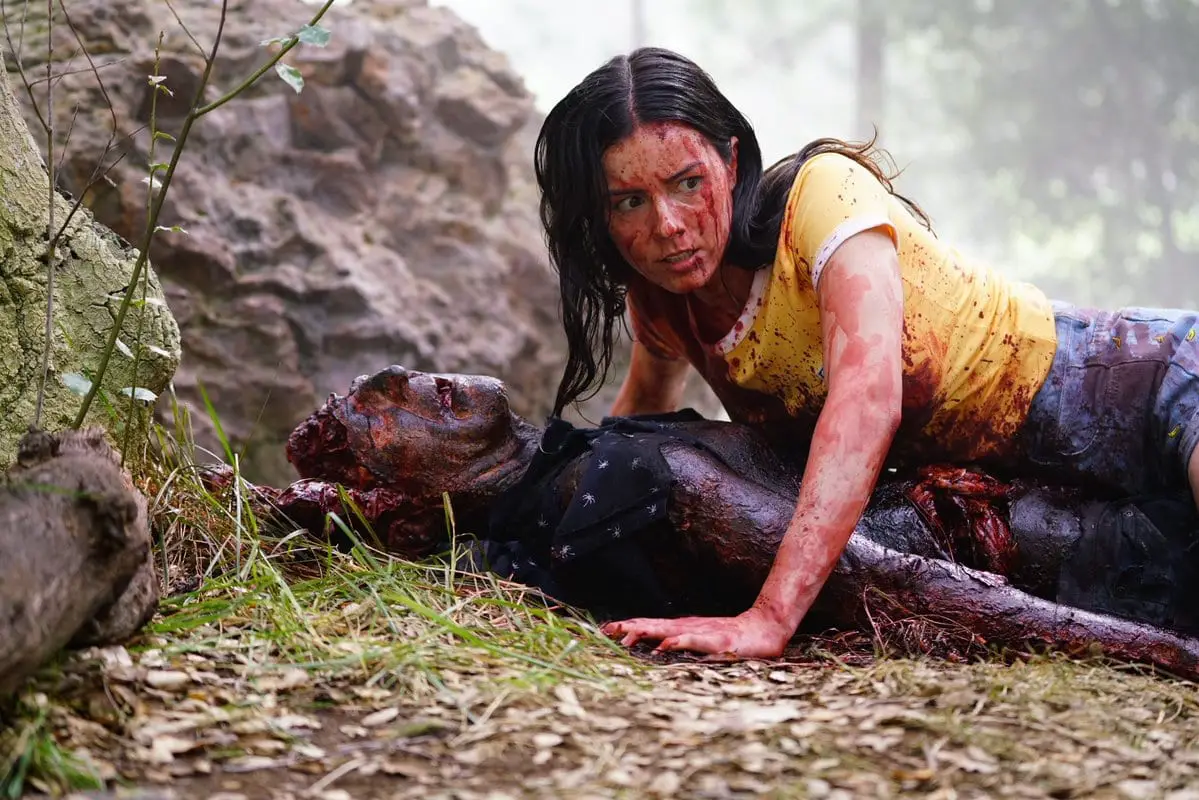
This story begins at the third act of a slasher movie, with Samantha (Sarah Elizabeth Winters) running for her life from a killer named the Welder. Her and her boyfriend (Kevin Fonteyne) go through the usual slasher shenanigans of running through the woods, trying to get help from a cop only for the said cop to bite the dust, running to a cabin, confronting the villain, someone getting got, discovering bodies in the basement, etc. etc. Just as Samantha is going to deliver the finishing blow, the short film shifts gears and goes in a whole other direction, explaining the motivations behind the Welder and flipping your notions of slasher movies on its head.
This one had potential and has some fun gory moments (with a particularly great head explosion delivered via shotgun), but the problem is that it goes on for far too long and is a lot less clever than it thinks. The first two acts of this short film feel like one extended joke that stopped being funny after five minutes. In one of the kill scenes, a character is pinned to the wall with a knife and reaches for another knife on the side table near them. The Welder grabs the knife instead and stabs the character. This goes on for about five more knives. It’s too long.
Once the big twist for why everything is happening is revealed, the film kind of picks up only because it’s not going through the motions exactly as we expect them to in scenes that go on for too long (even David Lynch would object to the length of these scenes). The problem is that the film then leans very heavily on god awful CGI (a feature that will crop up again in this anthology) when it should have stuck to practical effects. I only say that because the practical gore effects, when they’re there, are actually pretty solid.
The film just kind of ends with a shrug and a promise that the story isn’t actually over. It isn’t unique enough to be as long as it is, and it’s not even half as smart as it thinks it is. It thinks it’s Tucker and Dale vs Evil meets David Wong, but in reality, it’s more like Cabin in the Woods if Cabin in the Woods fell down an escalator shaft and lost all of its charm.
“Mirari” dir. Joe Dante
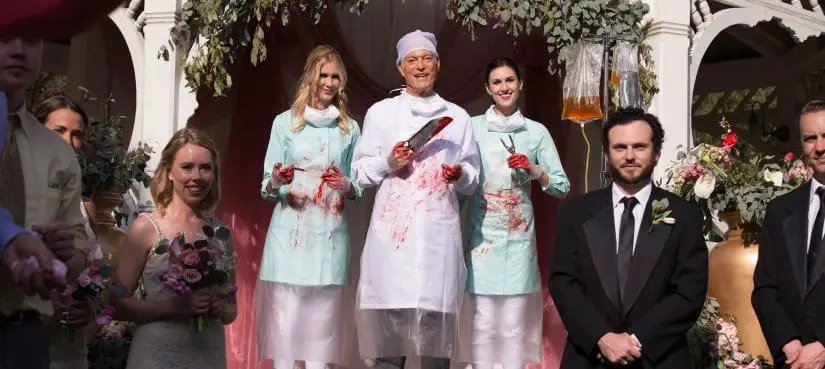
When a young woman with a scar on her face decides to get plastic surgery before her wedding (because everyone thinks she’s ugly even though she looks totally fine), she gets more than she bargained for and her fiance’s warnings that she’d look “just like his mom” turn out to be more accurate than she realizes.
Joe Dante is mostly known for his creature features, which is why it’s strange he instead attempted a Twilight Zone-esque morality story, with the message very obviously being “looks aren’t everything.” The problem is that it’s totally overshadowed by other stories like it, with a final reveal that honestly doesn’t make a ton of sense within the context of the story (I won’t spoil it, but it doesn’t take a genius to figure it out either). There’s some decent camera work when the protagonist is trying to escape the clinic in the middle of the night, but that’s about all that stood out to me.
This one is one giant shrug. The film making and performances are solid enough, and I appreciate Joe Dante stepping outside his comfort zone, but it didn’t really elicit much of a reaction from me one way or the other. If you want something that tackles the subject matter in a more interesting way, watch the classic Twilight Zone episode “Eye of the Beholder” or even the Seinfeld episode “The Nose Job.”
“Mashit” dir. Ryuhei Kitamura
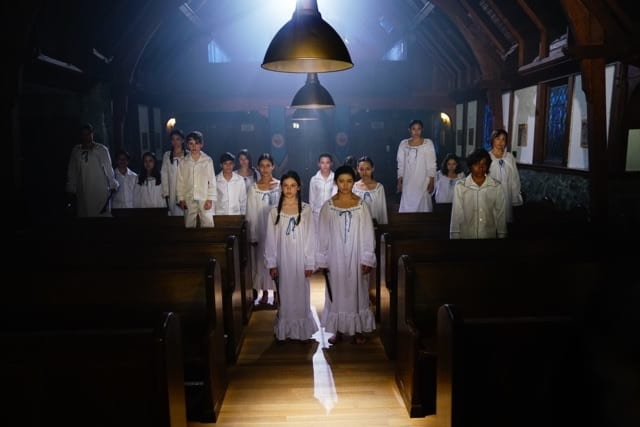
First off, I am going to do my damndest not to make any jokes about Gail, the Snail, but no promises (SHE’S MASHING IT).
Anyways.
When a kid at a religious church school commits suicide, weird things start happening and there are signs that a demon might be behind the mysterious, bloody patterns that appear in the chapel and the mysterious behavior of one of the young students (I can’t remember the name, so I can’t look up who the actress is, but it’s worth noting that she is just terrible in this film). The film eventually descends into a bloodbath that has some serious gall and ends on another open-ended note that isn’t terribly satisfying.
I don’t even know where to begin with this hot mess. Do I start with Gail the Sna- I mean the demon Mashit and how terrible his CGI is? Do I start with the fact that General Hospital’s Maurice Benard plays the Father in the Church who is also having an affair with one of the nuns? Or do I start with the climactic scene?
I’ll start with the editing. With short films, you still need a three-act structure, and up to this point, the films at least did a decent job of using a shortened version of that structure to tell their stories. With this film, though, the editing is flat and bizarre, jumping from one scene to the other with little rhyme or reason, and it feels like a feature-length film that was severely truncated to fit the half hour or so run time. None of the characters receive anywhere near enough development, which is something you can at least say in favor of the second film in this anthology. It’s tough to describe, but you watch this entry and something just feels… missing.
It’s mostly exorcism business as usual until the ending, with odd happenings around the Church and discovery of what’s going on. Then the climax hits. The demon is controlling a bunch of kids who confront the Father and nun in the chapel. The priest grabs a sword. At first, he’s punching all the kids and I thought, “Why even grab the sword?” Then my jaw hit the floor as the movie descends into a wholly tasteless and maybe-unintentionally hilarious bloodbath that was so audacious I couldn’t help laughing (I wonder what it says about me that I laugh about dead kids). It was so unexpected for this kind of movie and came absolutely out of nowhere, and I low-key love this entry for just how far it goes in the end.
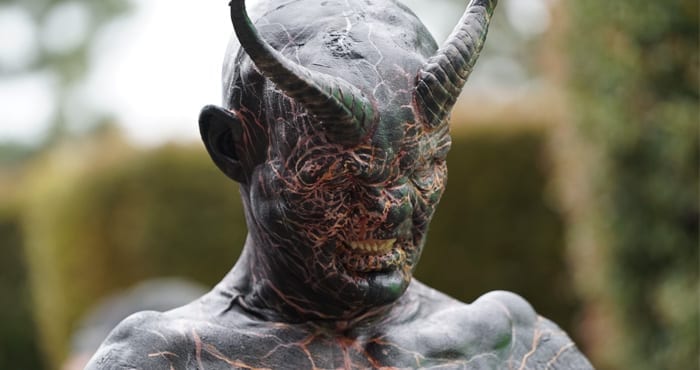
But that doesn’t redeem it of its flaws, including odd pacing, weird acting choices, and a flat out terrible CGI monsters whose appearance, despite being brief, elicits nothing but laughter. The climax almost makes it worth sitting through, depending on how ridiculous you like your movies. A positive note I will end on: there are a few times where the soundtrack swells using a fantastic mix of synth and electric guitar. It stood out since most of the score in this movie is fairly generic stuff. But on the whole, this is a weird and kind of stupid story about Gail the Snail haunting a bunch of devout Christians.
“This Way to Egress” dir. David Slade
A woman (played by Haunting of Hill House’s Elizabeth Reeser) goes to a psychologist at the request of her sons. It seems she suffers hallucinations that cause the environment around her to appear to decay and for people to grow ugly and bizarrely deformed. As the film goes on, it becomes clear that other forces besides mental illness are at play.
This, to me, is the bright spot in the anthology. It didn’t blow me away, but it stood out due to how downright moody it is. Shot all in black and white, the film makes fantastic use of the space around Reeser’s character, showing it grow slowly more corrupted as it goes on. It’s subtle and creepy, as is the way that the various characters also become corrupted. Reeser also gives a really solid performance that helps elevate some of the weaker elements such as the ending, which delivers too much exposition. I would have preferred it to be far more ambiguous, but a lot of what’s going on is explained pretty clearly.
It calls to mind Eraserhead in some ways, although it’s nowhere near as strong a film. But it delivers a creepy experience, one that favors a looming sense of dread and disturbing visuals instead of melodramatic music and generic storylines. The best thing I can say about it is that I wouldn’t mind seeing some kind of feature-length follow up that doubles down on the small amount of lore the short film builds.
“Dead” dir. Mick Garris
Garris directs the final film in this anthology that starts with a young boy’s family being murdered. After they leave his piano recital, a madman emerges from the trunk of their car and kills his parents and tries to kill him. It’s a very intense opening and very effective. But once it’s done, the film becomes a ghost story. Essentially, the kid can see ghosts since he crossed over to the other side, and the guy who killed his parents comes calling.
This one was just way too long, clocking in at close to 40 minutes. There was no reason for it to be this length, as the Sixth Sense element of him seeing dead people could have been axed entirely and nothing would have been lost. It attempts to make an emotional connection between the boy and his parents, as well as another character who can see ghosts, but the acting and effects are so hokey that they just become laughable. There’s a moment near the end where he sees his mother’s face in a ray of light and the effect was… well, imagine a tenth grader just discovering video editing technology being required to make a religious film and you have an idea for what kind of effect it is.
The biggest problem, though, is that the main character, Riley (Faly Rakotohavana) is not interesting in any way, and the actor wasn’t given enough direction to make us give a damn about what happens to him. And when your short film features him in almost every shot and runs around 40 minutes, that’s a huge, huge problem.
The film ends with this bloated, overstuffed ghost story that doesn’t do much to make the viewer care.
Conclusion
Nightmare Cinema is not as bad an anthology as the abysmal Holidays, but it’s painfully mediocre most of the time. It might be worth checking out for the utter lunacy that is the climax of “Mashit” and the genuinely creepy “This Way to Egress,” but I would suggest merely skipping the rest. Other anthologies are more deserving of your time and much more well suited to this spooky time of year.
Shudder provided a code for the purposes of this review.
Nightmare Cinema releases on Shudder October 29.


